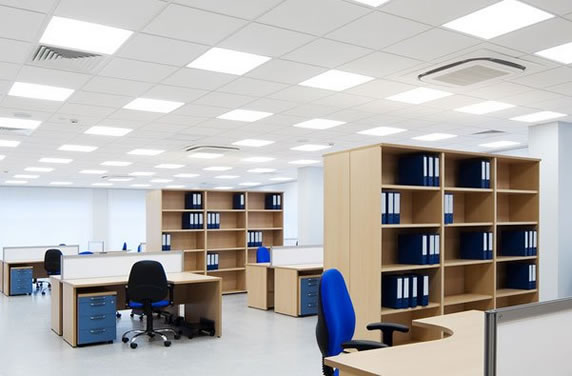
A common relamping practice, when upgrading from fluorescent to LED, is to fully replace all bulbs in an area after a number of expired individual bulbs have been swapped out.
How long does it take for the lifecycle costs of fluorescent fixtures to exceed LEDs? Do the maintenance requirements of fluorescent fixtures have an impact on these costs? How will the development of LED lighting affect the breakeven point between the two technologies? These questions and many others are frequently on the minds of anyone who is involved with the design or maintenance of lighting systems. While LED lighting technology is highly evolving and still has some maturity issues to work out, predictions indicate that a prominent role over fluorescent may occur in just a few short years.
To gain a better understanding of how these technologies compare, I performed an analysis by developing a model that would compare and contrast the construction costs, the energy demand, as well as the relamping and lamp recycling over 20 years. An educational institution is one that faces these real challenges and, as a result, was the model of choice to analyze these costs with a 150,000 square foot college classroom located in Boston, Massachusetts.
CONSTRUCTION COSTS
The initial purchase represents a large factor in any decision making process. To adequately capture these costs, the number of fixtures was determined by performing a foot candle calculation using Visual (Basic Edition), which is a software package for performing lighting calculations according to the Illuminating Engineering Society of North America’s lighting equations. The calculations resulted in 684 fixtures for both the three-lamp fluorescent and LED troffers, with the fluorescents having 2,052 lamps.
Using the number of fixtures, the construction costs were determined using the Electrical Construction Cost Data set in RSMeans Online with the LEDs having a total cost of $321k and the fluorescents being $143k. These costs included the material, labor, and equipment for the installation as well as the overhead and profit a Boston contractor would charge.
ENERGY DEMAND
The rising cost of energy directly impacts the operating costs of lighting systems and is a large concern in the selection of fixtures. To address this parameter the model’s lighting energy demand was modeled using eQuest, which is an energy analysis software application. Using an assumed operating period for the facility and the respective lighting loads from the foot-candle analysis with other default settings, the yearly energy consumption for the fluorescent and the LED fixtures was determined. At the time of writing, the area’s electrical supplier’s rate resulted in total yearly costs of $74k and $65k for the fluorescent and LEDs, respectively.
RELAMPING and RECYCLING
Facility maintenance expenses continue to get stretched further and further in this volatile economic climate, especially with large facilities where the labor costs of maintaining diverse systems can have a large impact on tight budgets. Due to these concerns, the expenses related to relamping and lamp recycling were included in this analysis. Relamping can be done in a variety of ways; the most expensive method (on a per lamp basis) is to replace them individually when they burn out, which is due to the inefficiencies related to low quantities.
The most cost effective method is to change all of the bulbs at one time regardless of their status. This is usually performed at a particular point of the lamp’s rated life. However, a common balance is to perform a combination of these where areas of a facility are fully replaced after a number of individual bulbs have been swapped out. This analysis addressed relamping by including both the full event as well as the individual efforts throughout the model. These calculations were performed through the use of a lamp mortality curve that displays the percent of lamps surviving against the lamp’s rated life. According to the curve, a batch of lamps at 100% of their rated life would see half of them expire and half of them remain operational. Using the Facility Construction Cost dataset in RSMeans Online, the cost of relamping the entire facility for each event was $22,800 and the cost of performing individual relamping processes ranged from $3,800 to $23,100. This range in cost was due to the variability in the number of bulbs that were burning out over time.
With the expiration of fluorescent lamps comes waste recycling and is another aspect that was deemed worthy of inclusion in this effort. Increased recycling charges on a per lamp basis were applied to the individual relamping method due to the economy of scale discounts that come with group relamping. However, the increased pickup charges were applied to the group relamping method due to the larger quantity of lamps.
CONCLUSIONS
The analysis indicates that despite the increased upfront costs of LED lighting, the operation and maintenance is significantly less than fluorescent fixtures making them a cost effective option especially when considering a long term comparison. The breakeven point for the two technologies ranges depending on the method of relamping with a 14 ½ year mark for the individual method and 19 years for the group. This relationship can be seen in the following figure where the increased upfront expense of LED lighting is apparent as well as the decreased energy and maintenance costs over time.
As the technology continues to mature, both the construction costs and energy requirements are expected to decrease causing the curves to move further in their favor. As a result, the presence of LED lighting in the market is expected to increase and continue and to do so at increasing rates. While this analysis was a snapshot in time of a rapidly changing technology, the day of a cost effective LED lighting solution may soon be upon us.
Adrian Charest
Adrian Charest is an Engineer / Editor with RSMeans / Reed Construction Data. He is the Senior Editor for the Electrical Cost Data, Electrical Change Order Cost Data, and the Metric Construction Cost Data books.

